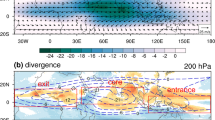Abstract
In this work, Princeton Ocean Model (POM) was used to study the formation of the South China Sea Warm Current (SCSWC) in the barotropic case. Monthly averaged wind stress and the inflow/outflow transports in January were used in the numerical simulation which reproduced the SCSWC. The effects of wind stress and inflow/outflow were studied separately. Numerical experiments showed that the Kuroshio intrusion through the Luzon Strait and the slope shelf in the northern SCS are necessary conditions for the formation of the SCSWC. In a flat bottom topography experiment, the wind stress driven northeast current in the northern SCS is a compensatory current.
Similar content being viewed by others
References
Chao Shenyu, Shaw Pingtung, Wang Joe, 1995. Wind relaxation as a possible cause of the South China Sea Warm Current.Journal of Oceanography 51: 111–132.
Guan Bingxian, 1978. The South China Sea Warm Current—an against wind current off Guangdong Province in winter.Oceanol. Limnol. Sin. 9(2): 117–127. (in Chinese with English abstract)
Guan Bingxian, 1985. Some features of the temporal and spartial distributions of the “counter-wind” current in northern South China Sea in winter,Oceanol. Limnol. Sin. 16(6): 429–438. (in Chinese with English abstract)
Guan Bingxian, 1998. A review of study on the South China Sea Warm Current.Oceanol. Limnol. Sin. 29(3): 322–328. (in Chinese with English abstract)
Guo Zhongxin, Huang Yuting, 1983. Effects of the cold wave on the warm current in the South China Sea.Tropic Oceanology 2(2): 102–107. (in Chinese)
Guo Zhongxin, Yang Tianhong, Chou Dezhong, 1985. The South China Sea Warm Current and its right side SW current in winter.Tropic Ocean 4(1): 1–9. (in Chinese)
Hellerman, S., Rosenstein, M., 1983. Normal monthly wind stress over the world ocean with error estimates.Journal of Physical Oceanography 13: 1093–1104.
Ma Hong, 1987. On the winter circulation of the northern South China Sea and its relation to the large scale oceanic current.Chin. J. Oceanol. Limnol. 5(1): 9–21.
Mellor, G. L., 1998. Users guide for a three-dimensional, primitive equation, numerical ocean model. Atmosphereic and Oceanic Sciences Program, Princeton University, 40 p.
Mellor, G. L., Yamada, T., 1982. Development of a turbulence closure model for geophysical fluid problem.Rev. Geophys. Space Phys. 20: 851–875.
Smogorinsky, J., 1963. General circulation experiments with the primitive equations. I. The basic experiment.Mon. Wea. Rev. 91: 99–164.
Su Jilan, Liu Xianbing, 1992. Numerical simulation of the circulation of the South China Sea. Symposium of Ocean Circulation, Ocean Press, Beijing, p. 206–215. (in Chinese)
Wyrtki, K., 1961. Physical Oceanography of the Southeast Asian Waters. NAGA Report Vol. 2, Scientific Results of Marine Investigations of the South China Sea and the Gulf of Thailand, Scripps Institution of Oceanography, La Jolla, Calif., 195 p.
Ye L., 1994. On the mechanism of South China Sea Warm Current and Kuroshio Branch in winter—preliminary results of 3—D baroclinic experiments.Terrestrial, Atmosphere and Ocean Sciences 5(4): 597–610.
Yuan Shurao, Deng Jiuzi, 1996. Preliminary study on the mechanism of the counter-wind current in winter and summer in the north South China Sea.Tropic Ocean 15(3): 44–51. (in Chinese)
Zeng Qicun, Li Rongfeng, Ji Zhongzheng, 1992. Numerical simulation of the monthly mean circulation in the South China Sea. Symposium of Ocean Circulation, Ocean Press, Beijing, p. 127–168. (in Chinese)
Author information
Authors and Affiliations
Additional information
Contribution No. 3618 from the Institute of Oceanology, Chinese Academy of Sciences.
Project 49576280 and 49876010 supported by NSFC, this work was also supported by KZCX2-202 from Chinese Academy of Sciences, the Major State Basic Research Program (No. G1999043808), partly supported by Visiting Scholar Foundation of Key-lab in the University of Ministry of Education of China and also partly supported by Key Laboratory of Marine Science and Numerical Modelling, SOA, Qingdao.
Rights and permissions
About this article
Cite this article
Kai, W., Yue, F. Numerical study on the formation of the South China Sea Warm Current I. Barotropic case. Chin. J. Ocean. Limnol. 19, 1–9 (2001). https://doi.org/10.1007/BF02842783
Received:
Accepted:
Issue Date:
DOI: https://doi.org/10.1007/BF02842783




